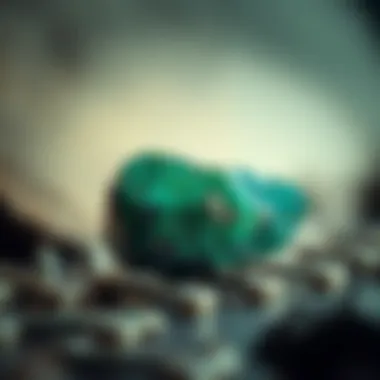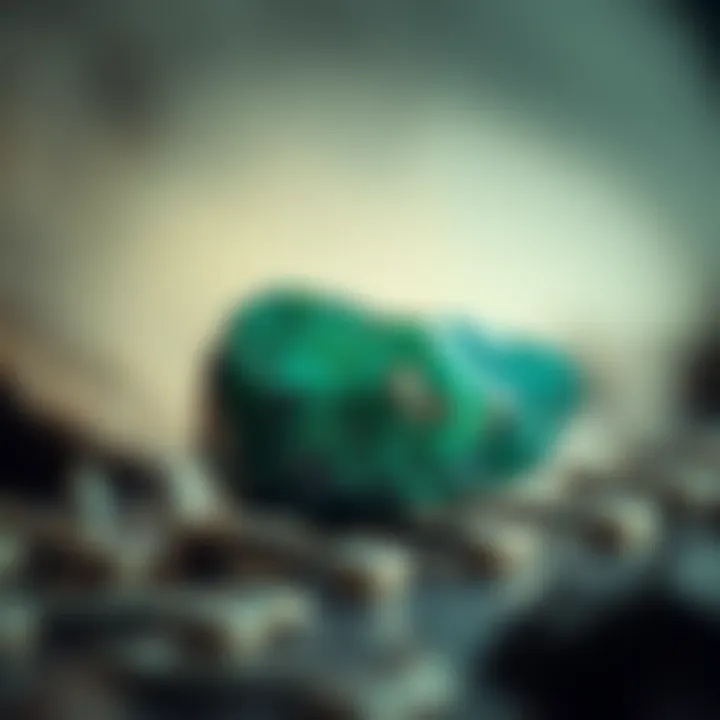Exploring Lodestone Magnetism: Importance and Uses


Intro
Lodestone, a naturally occurring magnet, has fascinated humanity for centuries. Its captivating properties have made it a significant tool in navigation and, more recently, in various technological applications. Understanding lodestone's unique magnetism requires not just a grasp of its physical characteristics but also an appreciation of its historical context and current relevance.
So, strap in as we delve deeper into the world of lodestones and their undeniable impact on both our past and present.
Foreword to Lodestone
Lodestone stands as a fascinating subject within the realm of geology and magnetism. Its unique magnetic properties, paired with a rich historical context, make it significant beyond its mere physical attributes. In this article, the focus is squarely on lodestone—the naturally occurring magnet that has played a pivotal role both scientifically and culturally.
Understanding lodestone is not just about its ability to attract iron; it encompasses an appreciation for the interplay between nature and human innovation. From the dawning of human consciousness, people have marveled at this mineral and its capabilities. The story of lodestone intertwines with the progress of navigation and even with the development of early scientific thought regarding magnetism. For rock and fossil collectors, lodestone isn't merely a specimen to behold; it's a symbol of mankind's quest for exploration and understanding the natural world.
Definition and Basic Properties
Lodestone, scientifically known as magnetite, is a naturally magnetized form of iron oxide. Its distinct properties allow it to attract ferromagnetic materials, presenting an almost mystical characteristic that has captured the imagination of many throughout history. The color of lodestone often ranges from black to dark brown, with a metallic luster that can catch the light just right, making it visually appealing as well. It can be found in various sizes, from small granules to larger masses, which has made it a valuable collectible.
Aside from its visual traits, lodestone’s magnetic properties are what truly set it apart. Unlike ordinary magnetite that can be processed and shaped, lodestone is already magnetized and retains this property without any external influence. This means that it can both attract other magnetic materials and exhibit north-south polarity, which is crucial for its historical applications in navigation. Rock collectors often prize lodestone not just for its aesthetic value but also for its intrinsic scientific significance.
Historical Context
Historically, lodestone is often credited with paving the way for the development of navigational tools. It is said that ancient mariners observed the magnetic nature of lodestone and utilized it to create the earliest compasses. Imagine the sailors of antiquity, relying on the skies and stars for guidance, but also depending on these natural magnets to find their way across treacherous waters. Such stories are woven into the very fabric of maritime exploration, highlighting how lodestone influenced seafaring culture.
In addition to navigation, lodestone has inspired various legends and mythologies. Many ancient civilizations regarded it as a source of mystical power. The Greeks, for example, associated it with the god of love, attributing its magnetic properties to divine intervention. Such beliefs underscore the deep cultural significance of lodestone, beyond its utility in navigation and science.
In closing, lodestone is not just a rock; it's a bridge connecting our past to the present. As we delve deeper into the geological, magnetic, and cultural aspects of lodestone in this article, readers will discover just how integral this mineral has been in shaping both human history and scientific advancement.
"Lodestone is like a compass in our collective memory, guiding us through the depths of time and knowledge."
For further reading on the intricate history and properties of lodestone, you might find resources like Britannica and Wikipedia illuminating.
This exploration sets the stage for understanding lodestone not just as a mineral but as an enduring artifact of human experience.
The Geology of Lodestone
The geology of lodestone is crucial to understanding its unique properties and its multifaceted role in both history and modern science. Lodestones serve not only as natural magnets but also as historical markers that offer insight into geological processes. To appreciate their significance, one must delve into how lodestones form and where they can be found in our world.
Formation and Composition
Lodestone, a naturally magnetized piece of the mineral magnetite, starts its life deep within the Earth's crust. This creation process is often tied to volcanic activity and metamorphic conditions. At high temperatures and considerable pressure, magnetite can crystallize from molten rock.
Here's what makes lodestone interesting:
- Magnetite Composition: The primary component is Fe3O4, an iron oxide. The unique arrangement of these iron and oxygen atoms gives lodestone its magnetic properties.
- Natural Magnetism: Unlike artificially magnetized items, lodestones attain their magnetism through this natural formation process. As they cool, certain mineral grains can align in response to the Earth’s magnetic field, forming a permanent magnet.
- Weathering Effects: Erosion can expose these magnetic minerals, leading to their extraction for use and study. As such, the environment can greatly influence their visibility and accessibility.
Distribution in Nature
When it comes to finding lodestones, they are not exactly sitting on every street corner. Their distribution is quite selective, often found in specific geological settings, which can be a boon for collectors and researchers alike.
- Global Locations: Key deposits are often found in areas rich in volcanic activity or metamorphic rocks. Regions such as the United States, especially in Michigan, or parts of Europe, like Norway, have notable lodestone occurrences.
- Wild in Nature: It’s fascinating to note that while some lodestones are mined, many are simply discovered during mineral hunts. They can sometimes appear nestled among other stones, waiting to be identified by keen eyes.
- Cultural Sites: Ancient ruins and archaeological digs can also be a goldmine for locating lodestones, as they were once believed to bear significant importance to navigation.
The geographical distribution of lodestones not only supports their collection but also opens doors to studying the geological history of regions where they are found. Understanding the environments that host these magnetic wonders can enhance a collector's appreciation of them, adding layers of context to a simple rock collection.
Magnetic Properties of Lodestone
Lodestone stands as a remarkable natural magnet, capturing the attention of scientists, collectors, and history enthusiasts alike. Its magnetic properties are essential, not just for understanding the material itself but also for the implications those properties have across various fields. This section will delve into the fascinating aspects of lodestone's magnetism, aiming to unpack its significance across history and modern applications.
Natural Magnetism Explained
To appreciate the allure of lodestone, one must first grasp what it means to be a natural magnet. Unlike synthetic magnets offered by modern technology, lodestone possesses magnetism due to its unique geological formation. Essentially, lodestone is a naturally occurring form of the mineral magnetite, which becomes magnetized through a process called thermoremanent magnetization. This phenomenon occurs when magnetite cools in the presence of a magnetic field, locking in its magnetic orientation.
This natural magnetism is critical for understanding lodestone's role in ancient navigation. Sailors used lodestones, either directly or as part of early compasses, to determine directions on the open seas. Lodestones generally exhibit a dipole nature, meaning they possess both a north and south pole. When freely suspended, the lodestone aligns itself with Earth's magnetic field.
"The utility of lodestone for navigation underscored not just its magnetic properties but also the ingenuity of ancient mariners in harnessing natural phenomena to guide their journeys."


The attraction and repulsion of lodestones towards iron and certain metals illustrate their practical uses in various applications from the past right up to modern times. For enthusiasts and collectors alike, the raw power of lodestone creates a tangible connection to both the earth and humanity's early explorations.
Comparison with Other Magnetic Materials
In the wider world of magnetism, lodestone serves as a compelling point of comparison with both natural and artificial magnetic materials. Traditional magnets, such as those made from ceramic or neodymium, are crafted to enhance their magnetic properties specifically. In contrast, lodestone's magnetism arises from its formation process, giving it a characteristic that is distinct and inherently authentic.
Here are several points of comparison between lodestone and other magnetic materials:
- Source of Magnetism:
- Strength of Magnetic Field:
- Environmental Impact:
- Cost and Accessibility:
- Lodestone: Naturally occurring magnetite.
- Synthetic Magnets: Engineered through industrial processes.
- Lodestone: Moderate strength, effective in specific applications like navigation.
- Synthetic Magnets: High strength, used in advanced technology and industrial applications.
- Lodestone: Minimal impact, extracted from natural sources with low processing.
- Synthetic Magnets: Production can involve environmentally harmful processes.
- Lodestone: Generally lower-cost for collectors due to natural availability.
- Synthetic Magnets: Varies widely based on material and application, often higher cost.
Understanding these differences is key for collectors and researchers. While synthetic magnets certainly have their place in modern technology, lodestone offers a unique glimpse into Earth's geological processes and connects us to earlier times, where human innovation rode on the back of natural phenomena.
Cultural and Historical Uses
The cultural and historical significance of lodestone cannot be overstated. This remarkable mineral has profoundly shaped human understanding of magnetism and navigation throughout the ages. Through a closer examination, we can observe how lodestone influenced various civilizations and contributed to a rich tapestry of symbolic meaning and practical applications.
Lodestone in Ancient Navigation
In antiquity, the ability to navigate the seas was crucial for trade, exploration, and military endeavors. Lodestone, with its unique magnetic properties, served as the first reliable compass for ancient mariners, allowing them to traverse unknown waters. The Greeks and Chinese, among others, discovered that lodestone could attract iron, and they soon adapted this phenomenon for navigation purposes.
- Greek Navigators: Scribes from ancient Greece meticulously documented how lodestone could assist sailors in orienting themselves, especially during cloudy days or at night when stars were obscured. They often placed a piece of lodestone on a wooden board, allowing it to point towards magnetic north. This provided a rudimentary but effective means of navigation.
- Chinese Advances: In China, the lodestone compass became an invaluable tool by the 4th century AD. Not only did it aid maritime travel, but it facilitated overland journeys as well. The Chinese documented their findings, leading to further innovations and enhancing the understanding of magnetic phenomena.
The establishment of lodestone as a guiding star of sorts for ancient navigators changed the course of human history, marking the beginning of long-distance travel that would soon connect different cultures and continents.
It’s a well-known surgical fact: The development of navigation techniques greatly influenced global trade and exploration.
Symbolism and Mysticism
Beyond its practical applications, lodestone also found its place in the realms of symbolism and mysticism. Different cultures imbued this mineral with various interpretations and beliefs, often viewing it as a conduit to otherworldly powers or as a protector against misfortune.
- Symbol of Attraction: Lodestone was often seen as a symbol of attraction, due to its magnetic properties. People believed it could draw love, prosperity, and good fortune. Talismans crafted from lodestone were common, especially among sailors who sought protection during their voyages.
- Spiritual Properties: Various spiritual practices recognized lodestone's ability to connect with energies, thus creating a conduit between the earthly and the spiritual realms. It was used in rituals and meditations to enhance focus and clarity, and many believed it could align energies within the body.
- Alchemy and Healing: Lodestone also appeared in alchemical texts, where it served as a metaphor for transformation. Alchemists would describe the process of changing base elements into gold, likening it to how lodestone could change iron into a magnetized form. Furthermore, some folk medicine practices touted lodestone for its purported healing effects, claiming that it could relieve ailments related to the circulatory system by enhancing blood flow.
The dual role of lodestone as a navigational tool and a mystical object reflects humanity’s long-standing fascination with the natural world. Whether it served a practical purpose or fed into the realm of belief, lodestone's versatility and significance are truly remarkable.
Scientific Significance of Lodestone
Lodestone's scientific significance cannot be overstated, especially when we consider its multifaceted contributions to various fields, including geology, physics, and environmental science. This unique mineral, composed chiefly of magnetite, has played a pivotal role in the evolution of our understanding of magnetism over the ages. The study of lodestones not only sheds light on the properties of magnetic materials but also serves as a gateway into the realm of geomagnetism, a field that holds critical insights into Earth's processes.
Contributions to the Understanding of Magnetism
Lodestone has been instrumental in developing theories related to magnetism. Its natural magnetism, which can be observed without any human intervention, has been a source of curiosity for scientists and scholars for centuries. By examining lodestones, researchers have been able to identify key aspects of magnetic phenomena. For instance, lodestones exhibit a phenomenon known as magnetic polarity, which means they have a north and a south pole.
This observation leads to crucial understanding regarding:
- Magnetic Field Mapping: Lodestones have helped scientists understand how Earth's magnetic field is structured and how it behaves. This knowledge is pivotal when it comes to applications, such as navigation.
- Electromagnetism: Studies on lodestones contributed significantly to the foundation of electromagnetism. Pioneering scientists like William Gilbert used lodestones to build theories that laid groundwork for modern physics.
- Magnetic Domains: The exploration of lodestone's magnetic properties has also advanced our understanding of magnetic domains—regions within magnetic materials where the magnetic fields of the atoms are grouped together.
Through these contributions, lodestone has not only shaped theoretical frameworks but has also provided methodologies for practical applications in various technologies that rely on magnetic principles.
Research in Geomagnetism
As we journey deeper into geomagnetism, we find that lodestone serves as both a historical artifact and a modern investigational tool. The way lodestones record ancient magnetic fields allows researchers to delve into the planet's geological and environmental history. This historical record can offer insights into:
- Plate Tectonics: The magnetic properties embedded in lodestones can indicate movements of tectonic plates over extensive periods, helping scientists decipher the past configurations of continents.
- Solar Activity: Changes in the geomagnetic field, often influenced by solar activities, can be studied through lodestones, which may provide clues about solar radiation effects on the magnetosphere.
- Climate Change: Research on lodestone deposits can yield data on historical climate patterns, offering essential perspectives on how climate change has evolved alongside geological events.
By integrating lodestone studies into the broader context of geomagnetism, scientists can better understand the dynamic processes shaping our planet. Lodestones hold the key to unlocking many mysteries of Earth’s magnetic history and provide tools to evaluate how these phenomena can influence current environmental challenges.


"Lodestones have acted as a natural compass throughout ages, guiding early navigators and now scientists in their pursuit of planetary mysteries."
Research on lodestones not only enhances our scientific knowledge but also fosters environmental awareness, as understanding these natural magnets helps us appreciate the delicate balance we must maintain with our planet's magnetic systems.
Modern Applications of Lodestone
Lodestone, with its unique magnetic properties and historical significance, continues to find relevance in modern applications that range from technology to education. Understanding these applications not only highlights its practical uses but also reflects the enduring connection between nature and human ingenuity. This section delves into the diverse applications of lodestone, emphasizing its contributions to various sectors and the benefits it provides.
Technology and Industry
When we think about the significance of lodestone in technology, first thoughts might revolve around the field of magnetics. Lodestone is considered a natural magnetic mineral, and its properties are harnessed in a variety of industrial applications. Its magnetic field can be utilized in the designs of certain types of compasses, alongside more advanced magnetic systems used in navigation devices. It’s like having a piece of the Earth itself guiding your way.
Some specific uses in technology include:
- Magnetic Sensors: Lodestones are incorporated in sensors that detect magnetic fields, making them valuable in many electronic devices. They can aid in the performance of smartphones or navigation systems.
- Alternative Energy: In some renewable energy applications, lodestone is investigated for its ability to help create more efficient electromagnets, potentially leading to advancements in wind energy turbines.
In industry, lodestone also plays a role in the larger context of magnetic sorting systems. Modern sorting machines utilize powerful magnets to separate metals from non-metals, enhancing recycling efforts.
Educational Uses and Practical Demonstrations
Lodestone is an excellent educational tool, especially for those teaching or learning about magnetism. Its natural properties allow for hands-on demonstrations that can ignite curiosity about the principles of magnetic fields. In classrooms, lodestone can be used effectively to illustrate basic physics concepts, providing a tactile experience that enhances learning.
Practical demonstrations involving lodestone can include:
- Magnetic Field Experiments: By placing small iron filings on a piece of paper over a lodestone, one can visualize the magnetic field lines, making the invisible forces at play more tangible.
- Interactive Learning Stations: Setting up stations with lodestones, compasses, and various metallic objects allows students to experiment and discover how different materials interact with magnetism, fostering engagement through exploration.
In addition to aiding traditional education, lodestone finds a footing in specialized science fairs and exhibitions, where it can showcase the wonders of geology and physics in a captivating manner.
"The magnetic effects of lodestone are not just a subject of study; they become an interactive gateway to understanding complex scientific ideas."
As we look into the horizon of technology and education, lodestone maintains a steady presence, bridging the gap between ancient knowledge and modern innovations. By facilitating both industrial progress and educational exploration, lodestone demonstrates its lasting significance and versatility.
Preservation and Collection of Lodestones
Lodestones, with their fascinating magnetic properties and historical importance, deserve proper preservation to ensure that future generations can appreciate and study them. Collecting lodestones is not just about accumulating specimens; it involves a responsibility to maintain their integrity and authenticity. The act of preserving these natural magnets gives collectors a tangible link to the past while providing a foundation for ongoing research into their unique properties.
When one considers the significance of lodestones in both science and culture, the urgency of their preservation becomes evident. As geological formations change with time due to erosion and human activity, many naturally occurring lodestones are at risk. Therefore, collectors must acknowledge their role in safeguarding these treasures, ensuring that they are available for educational purposes and scientific inquiry.
Best Practices for Collectors
Collecting lodestones comes with a set of principles that, if followed, will enhance the quality and longevity of the collection. Here are several key practices:
- Documentation: Keeping thorough records of where each lodestone was found, its characteristics, and any related geological details is crucial. This information can help contextualize the specimen and link it to scientific databases.
- Storage: Store lodestones in a cool, dry place. Exposure to moisture can lead to deterioration, and keeping them in airtight containers can prevent moisture-related damage.
- Handling: Always handle lodestones with care. When holding a lodestone, avoid touching it with bare hands to minimize oil transfer, which may impact its aesthetic appeal over time.
- Display: When exhibiting lodestones, ensure they are securely mounted to avoid accidental damage. Use display cases that provide protection from dust and accidental contact.
By adhering to these practices, collectors can ensure that they are maintaining the high standards expected in the collecting community. High-quality documentation and responsible handling not only preserve the specimens but also enrich the lore surrounding them for future enthusiasts.
Conservation Techniques
Conservation is an essential aspect that goes hand-in-hand with collection. Proper conservation techniques can significantly extend the lifespan of lodestone specimens. Here’s how collectors can effectively conserve their lodestones:
- Cleaning: When cleaning lodestones, use a soft brush or a damp cloth to remove dust and debris. Avoid harsh chemicals which can damage the surface and remove any natural patina.
- Monitoring Condition: Regularly inspect the physical condition of each specimen. Look for signs of degradation such as cracks, discoloration, or magnetic degradation. Early detection can prevent further damage.
- Preventative Measures: Consider environmental factors that could cause harm, such as sunlight exposure, humidity fluctuations, or temperature changes. Keeping lodestones in climate-controlled environments can help mitigate these risks.
- Consulting Experts: When in doubt, it's often best to consult a professional conservator who specializes in mineralogy. Engaging experts will provide you with insights and techniques specific to lodestone care that might not be common knowledge among collectors.
"Effective preservation ensures that the treasures of our geological past don’t simply fade into oblivion but remain forever available for our curiosity and research."
Utilizing these conservation tips will help collectors keep their lodestones in as pristine a condition as possible. As these remarkable natural magnets continue to play a role in science and history, responsible preservation becomes paramount to sustaining their legacy.
Lodestone in Popular Culture
The lodestone, known for its magnetic properties, has threaded its way through the fabric of various cultures throughout history. Its significance extends beyond mere scientific inquiry, embedding itself in the arts, literature, and even modern media. This section explores how lodestone has influenced cultural narratives, enriching our understanding of its impact on society.
Representation in Literature and Art
Historically, lodestone has sparked the imagination of writers and artists alike. One prominent example can be found in medieval literature, where lodestones were often depicted as symbols of love and attraction. The idea that the stone could draw objects and, in a metaphorical sense, people together has been interpreted within numerous poetic works.


In more contemporary literature, author H.P. Lovecraft couldn’t resist employing lodestones in his cosmic horror sagas, aligning their magnetism with themes of fate and unavoidable attraction. These literary representations reveal how the lodestone serves not just as a physical object, but as a conduit of deeper human experiences and emotions.
Moreover, in visual arts, artists such as Anselm Kiefer have used earth materials in their works to create a dialogue about nature’s forces and humanity's connection to the earth. These artistic expressions echo the dynamic power of lodestone, highlighting the intersection of science and art through approaches that challenge viewers to reconsider their relationship to natural phenomena.
Key Themes in Literature and Art
- Magnetism as Metaphor: Many writers use lodestone as a symbol of attraction, love, or fate.
- Nature's Power: Artists often depict the raw power of nature by incorporating materials like lodestone in their creations.
- Cultural Significance: The stone has been intertwined with cultural narratives, pointing to humanity's reliance on natural elements for inspiration.
Lodestone in Modern Media
In today's media, lodestones have not vanished into obscurity; they continue to intrigue audiences. Podcasts focusing on geology often mention their unique properties, while documentaries explore how lodestones have guided explorers and influenced navigation techniques. Given the renewed interest in sustainable practices, lodestones’ natural magnetism has even found its way into discussions about renewable energy sources.
Movies and television shows sometimes delve into the mystical or scientific aspects of lodestone, portraying characters using its magnetic properties in creative ways. In science fiction narratives, it often serves as a plot device that underscores the power and mystery of nature. The fusion of ancient knowledge and modern interpretations provides a fresh perspective for viewers and listeners, further securing lodestone's place in contemporary culture.
Moreover, social media platforms, especially those targeting enthusiasts of science and history, frequently highlight stunning visuals of lodestones. This favorable representation can inspire a new generation of collectors and enthusiasts to appreciate the stone, not only for its physical beauty but also for its historical significance.
"Lodestone is not simply a geological specimen; it is a cultural artifact that embodies the dialogue between humanity and nature."
End
In summary, the representation of lodestone in literature, art, and modern media underscores its multifaceted role in shaping cultural narratives. Whether as a poetic device or a tool in scientific exploration, lodestone continues to capture human imagination. Its journey through popular culture illustrates a vital connection, enriching not only our understanding of magnetism but also our shared human experience.
Future Research Directions
Exploring the future research directions related to lodestone magnetism is essential for several reasons. As the understanding of magnetism evolves, the significance of lodestones in both historical contexts and modern applications continues to emerge. This article's section on future research highlights areas that not only promise to deepen our scientific knowledge but also reveal innovative pathways for practical application.
Innovative Studies in Magnetism
The landscape of magnetism research is ever-changing, driven by advances in technology and a greater need for sustainable solutions. One promising avenue of study is the behavior of lodestones under varying environmental conditions. Researchers are keen on investigating how temperature fluctuations, geological transformations, and chemical interactions can influence the magnetic properties of lodestones.
Recent studies have suggested a correlation between magnetic anomalies and geological formations. Such findings could foster new insights into how the Earth's magnetic field interacts with different minerals. For instance:
- Geo-magnetic surveying: Using lodestones' magnetic characteristics to map geological features.
- Environmental monitoring: Observing changes in lodestone output to assess ecosystem shifts.
Furthermore, interdisciplinary studies incorporating physics, geology, and environmental science are becoming more common. Collaborations could lead to the development of hybrid materials that mimic lodestone properties, which might serve in various innovative applications, from energy storage to advanced navigation systems. As scientists delve deeper into these studies, the possibilities for lodestone research could very well create ripple effects across multiple fields of inquiry, thereby enhancing both our theoretical and practical understanding of magnetism.
Potential Industrial Applications
As knowledge about the unique properties of lodestones expands, so too do the potential industrial applications. Lodestone's inherent magnetism offers a variety of practical uses that businesses and researchers are only beginning to explore.
Some exciting applications include:
- Geological Exploration: Lodestones can enhance the accuracy of mineral prospecting. Given their magnetic properties, they can help identify deposits of minerals that are otherwise challenging to locate.
- Renewable Energy Technologies: There's a rising interest in using lodestones in the development of magnet-based energy systems. This might involve harnessing their magnetic energy to improve efficiency in wind turbines or magnetic levitation systems.
- Medical Imaging: Preliminary research indicates that lodestone particles could play a role in enhancing the contrast in magnetic resonance imaging (MRI) scans, potentially leading to sharper image quality and better diagnostic capabilities.
By tapping into these applications, industries can not only create more efficient processes but also contribute to sustainability efforts. With the ongoing exploration of lodestones, the industrial landscape may soon be ripe with opportunities that blend ancient knowledge with cutting-edge technology.
Lodestone research stands at the crossroads of tradition and innovation, where the past informs the future.
As the scientific community continues to investigate, it’s clear that lodestone magnetism holds a wealth of potential waiting to be unlocked. Collaborations and innovative studies may yield transformative technologies, thereby ensuring the relevance of lodestone for generations to come.
Ending
The exploration of lodestone magnetism culminates in an appreciation of its multifaceted significance across various domains. From the natural sciences to cultural histories, lodestones represent more than mere geological formations; they symbolize our enduring quest to understand the forces that shape our world. This conclusion synthesizes key insights, reflecting on the importance of this material while considering future implications for research and technology.
Summary of Key Insights
Lodestone, known for its distinctive magnetic properties, has captured the attention of both scientists and scholars alike. Key takeaways from the previous sections include:
- Natural Magnetism: The intrinsic magnetic qualities of lodestone arise from its iron-rich composition, which makes it a fascinating subject for both amateur and professional collectors. This natural phenomenon demonstrates how mineral structures can affect magnetic fields.
- Historical Uses: Ancient navigators relied on lodestones for navigation, assisting in maritime voyages long before modern compasses came into play. This historical context enriches our understanding of humanity's relationship with natural resources.
- Scientific Contributions: Lodestones have provided foundational knowledge for the study of magnetism and its applications in geomagnetism. Researchers continue to explore their relevance, potentially unveiling new insights that could influence technological advancements.
As we consider the rich history and complex scientific value of lodestone, it becomes clear that these materials are not just relics of the past but are gateways to future discoveries. This knowledge assists collectors and scientists alike, ensuring that lodestones remain significant in educational contexts and practical demonstrations.
Final Thoughts on Lodestone's Impact
The impact of lodestone extends far beyond its magnetic properties. It has played an essential role in the development of navigational tools and continues to inspire researchers in their quest to understand geophysical phenomena. Moreover, its presence in contemporary technology, particularly in electronics and magnetics, underscores its relevance in today’s rapidly evolving landscape.
In the grand tapestry of geology and human history, lodestone remains a vital thread. For rock and fossil collectors, recognizing the significance of lodestone allows for a deeper appreciation of their collections. They are not just beautiful specimens; they are connections to our past, intersections of science and culture, and indicators of future scientific inquiries.
"Lodestone serves as a bridge between ancient navigation wisdom and the frontiers of modern magnetic research."
Through ongoing study and engagement with lodestones, we not only celebrate their historical significance but also pave the way for future research directions, ensuring that this remarkable mineral retains its importance in science and society at large.



